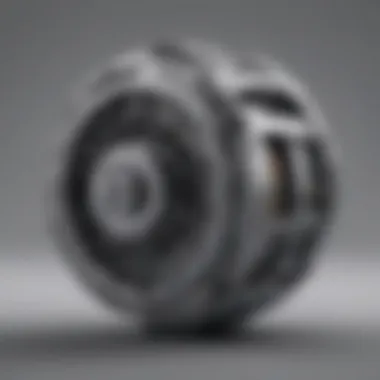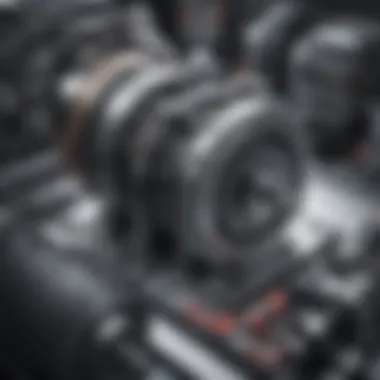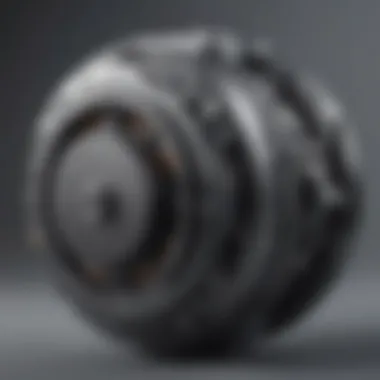Unveiling the Intricacies of Electric Drive Motors: A Complete Overview


Overview of Topic
Electric Drive Motors are a fascinating subject that has a significant impact on modern technology. Understanding the core of these motors can provide a profound insight into their workings, applications, and importance in various industries. The evolution of electric drive motors has been remarkable since its inception, shaping the foundation for our current technological landscape.
Fundamentals Explained
Electric Drive Motors operate based on fundamental principles rooted in electromagnetic theory and mechanics. Key terminologies such as torque, horsepower, and efficiency are essential to grasp the functioning of these motors. Gaining a solid understanding of the basic concepts is crucial before delving deeper into practical applications.
Practical Applications and Examples
Real-world applications of Electric Drive Motors range from electric vehicles to industrial machinery. Case studies highlighting the successful integration of these motors in different sectors shed light on their versatility and efficiency. Hands-on projects and code snippets offer practical insights into implementing and optimizing electric drive systems.
Advanced Topics and Latest Trends
The field of Electric Drive Motors is advancing rapidly, incorporating cutting-edge technologies such as regenerative braking and sensorless control. Techniques like field-oriented control and model predictive control are revolutionizing motor efficiency and performance. Exploring future prospects reveals exciting developments in AI integration and smart motor systems.
Tips and Resources for Further Learning
To deepen your knowledge of Electric Drive Motors, exploring resources like 'Electric Drives' by Ned Mohan and online courses on motor control can be beneficial. Software tools like MATLAB Simulink provide a hands-on platform for simulating and testing motor control algorithms, enhancing practical understanding for enthusiasts and professionals.
Introduction to Electric Drive Motors
Electric drive motors are a pivotal component in modern technology, revolutionizing various industries with their efficiency and versatility. This section delves into the fundamental aspects of electric drive motors, shedding light on their intricate mechanisms and practical applications. Understanding the basics of electric drive motors is crucial for grasping their significance in propelling technological advancements. From electric motor fundamentals to exploring the different types of electric motors and key components, this section serves as a foundational guide for readers.
Understanding the Basics
Electric Motor Fundamentals
Electric motor fundamentals are the backbone of these motors, outlining their operational principles and functionalities. These fundamentals play a vital role in converting electrical energy into mechanical energy, driving the entire system. The key characteristic of electric motor fundamentals lies in their ability to generate rotational motion efficiently, making them a popular choice across various applications. The unique feature of electric motor fundamentals is their simple yet robust design, offering reliability and high performance. However, one drawback could be the need for regular maintenance to ensure optimal functioning.
Types of Electric Motors
Exploring the diverse types of electric motors reveals a range of functionalities tailored to specific industrial needs. Each type brings its unique advantages and limitations, catering to different requirements. The key characteristic of types of electric motors is their specialized design to deliver varying torque and speed outputs, making them suitable for specific tasks. This specificity enhances the overall efficiency and effectiveness of electric drive systems. Despite the diversity in types, all aim to convert electrical energy into mechanical motion efficiently.


Key Components
The key components of electric drive motors play crucial roles in their overall performance and reliability. These components include the rotor, stator, windings, and additional elements that work in harmony to generate motion. The key characteristic of these components is their seamless integration to ensure smooth and efficient operation. The unique feature lies in the synchronized function of these parts, showcasing the complexity behind the seemingly simple motor design. However, the intricate nature of these components may pose challenges in terms of maintenance and troubleshooting.
Historical Evolution
Pioneering Inventions
The historical evolution of electric drive motors traces back to pioneering inventions that laid the foundation for modern motor technology. These inventions marked significant milestones in harnessing electricity for mechanical power, shaping the industrial landscape. The key characteristic of pioneering inventions is their innovative approach to utilizing electricity for generating motion, influencing subsequent developments. The unique feature of these inventions is their contribution to accelerating technological progress, albeit with initial limitations and constraints.
Technological Advancements
Technological advancements have propelled electric drive motors into new frontiers, enhancing their efficiency and reliability. These advancements have optimized motor performance, introducing novel features and capabilities. The key characteristic of technological advancements is their continuous strive for more efficient and sustainable motor solutions. The unique feature lies in the integration of modern technologies to improve motor functionality, ushering in a new era of automation and electrification.
Importance in Modern Technology
Integration in Automotive Industry
The integration of electric drive motors in the automotive industry signifies a significant shift towards sustainable transportation solutions. These motors power electric vehicles, offering emission-free mobility options. The key characteristic of this integration is its contribution to reducing carbon footprints and mitigating environmental impact. The unique feature lies in the transformative role of electric motors in redefining traditional automotive norms, paving the way for a greener future.
Role in Sustainable Energy Solutions
Electric drive motors play a crucial role in sustainable energy solutions, driving the adoption of renewable power sources. These motors power wind turbines and solar systems, harnessing clean energy for various applications. The key characteristic of their role in sustainable energy solutions is their contribution to reducing reliance on fossil fuels and promoting eco-friendly practices. The unique feature lies in the resilience and adaptability of electric motors in meeting the dynamic energy needs of modern society.
Operational Principles of Electric Drive Motors
In this segment, we delve deep into the Operational Principles of Electric Drive Motors, a crucial aspect of understanding the intricate mechanisms behind these devices. The operational principles are the backbone of how electric drive motors function and their significance cannot be overstated. By comprehensively detailing the operational principles, readers will gain a profound insight into the inner workings of these motors. One must grasp how mechanical structures and power conversion processes affect efficiency and performance to appreciate the role of operational principles fully. Understanding these principles is essential for individuals in various fields, from automotive engineering to renewable energy solutions.
Mechanical Structure
Rotor and Stator Configuration
The rotor and stator configuration plays a pivotal role in the functionality of electric drive motors. The specific arrangement of the rotor and stator determines the motor's efficiency, torque generation, and overall performance. The key characteristic of this configuration lies in the magnetic interaction between the two components, essential for generating motion within the motor. The rotor and stator configuration is a popular choice due to its simplicity and reliability, making it a preferred option in various applications. Despite its effectiveness, one must consider limitations such as structural constraints and material fatigue. The unique feature of this configuration is its ability to produce a consistent magnetic field, contributing significantly to the motor's operational efficiency.
Function of Windings


The function of windings is an integral aspect of the mechanical structure in electric drive motors. Windings are responsible for creating magnetic fields that interact with the rotor and stator, facilitating the conversion of electrical energy into mechanical motion. The key characteristic of windings is their composition of insulated wire coils, designed to withstand high currents and generate powerful magnetic fields. This feature makes windings a popular choice in motor design, ensuring robust performance and longevity. However, the complexity of winding configurations can pose challenges in manufacturing and maintenance processes. Despite this, the unique feature of windings lies in their ability to control motor speed and torque precisely, enhancing operational flexibility and performance.
Power Conversion Process
AC to Conversion
The AC to DC conversion process is a critical element in electric drive motors, enabling the seamless integration of these motors in various applications. Converting alternating current (AC) to direct current (DC) allows for efficient power transmission and control within the motor system. The key characteristic of this conversion lies in its ability to regulate voltage and current levels, optimizing motor performance under different operating conditions. This feature makes AC to DC conversion a popular choice for its adaptability and energy efficiency benefits. However, concerns may arise regarding power losses and heat generation during the conversion process. The unique feature of AC to DC conversion is its ability to support variable speed operations, enhancing the motor's versatility and application range.
Controlling Speed and Torque
Controlling speed and torque is a critical aspect of electric drive motors that directly impacts their operational efficiency and performance. The ability to adjust speed and torque output allows for precise control over motor operations, catering to diverse application requirements. The key characteristic of this control mechanism lies in its responsiveness to external commands, facilitating real-time adjustments for optimal motor performance. This feature makes speed and torque control a popular choice in industries requiring dynamic operational capabilities. However, challenges may arise in fine-tuning control algorithms and maintaining stability at varying load conditions. The unique feature of controlling speed and torque is its capacity to achieve high accuracy and consistency in motor responses, enhancing overall system reliability and productivity.
Efficiency and Performance
Factors Affecting Efficiency
Factors affecting efficiency play a crucial role in determining the overall performance of electric drive motors. Various elements, such as temperature, cooling systems, and mechanical losses, can influence the motor's efficiency levels significantly. Understanding these factors is essential for optimizing motor operations and promoting energy savings. The key characteristic of efficiency factors lies in their direct impact on power consumption and heat dissipation, highlighting the importance of efficient motor design and operation. This emphasis on efficiency underscores the increasing demand for eco-friendly and sustainable motor solutions in modern industries. Despite advancements in efficiency technologies, challenges persist in balancing performance requirements with energy conservation goals. The unique feature of efficiency factors is their ability to drive continuous innovation in motor design and operation, aiming for heightened performance standards and environmental stewardship.
Enhancing Motor Performance
Enhancing motor performance is a constant pursuit in the realm of electric drive motors, driven by the need for superior efficiency and operational capabilities. Innovations in motor design, control systems, and material technologies contribute to enhancing motor performance across various industries. The key characteristic of performance enhancement lies in its multidisciplinary approach, integrating mechanical, electrical, and software solutions to achieve optimal motor function. This holistic perspective is crucial for addressing performance bottlenecks and unlocking the full potential of electric drive motors. Despite the benefits of performance enhancements, challenges may arise in cost-effectiveness and compatibility with existing infrastructure. The unique feature of enhancing motor performance is its capability to revolutionize industrial processes, paving the way for smarter technologies and sustainable practices.
Applications Across Industries
Electric drive motors play a pivotal role in various industries, showcasing their versatility and efficiency. In this comprehensive guide, we delve into the significance of electric drive motors in different sectors, highlighting their unique benefits and considerations. From enhancing operational processes to boosting sustainability, the applications of electric drive motors across industries are vast and impactful. These motors are integral in the automotive sector, industrial automation, and renewable energy, revolutionizing how various operations are conducted.
Automotive Sector
In the automotive sector, electric drive motors, especially in Electric Vehicle Propulsion, have brought about a significant shift towards sustainable transportation solutions. Electric Vehicle Propulsion emphasizes the use of electric motors for vehicle movement, reducing reliance on traditional fuel sources and lowering carbon emissions. The key characteristic of Electric Vehicle Propulsion lies in its efficiency and eco-friendliness, making it a popular choice for modern automotive innovation and aligning with the current global push towards sustainable practices. The unique feature of Electric Vehicle Propulsion is its ability to provide instant torque, contributing to a smoother driving experience. However, challenges such as range anxiety and infrastructure development still exist in fully integrating electric motors into mainstream automotive practices.
Advanced Driver Assistance Systems (ADAS) represent another crucial aspect in the automotive sector, enhancing vehicle safety and improving driving experiences. These systems utilize electric drive motors to assist drivers in various scenarios, such as automated parking and collision avoidance. The key characteristic of ADAS is its focus on enhancing driver and passenger safety through advanced technological interventions. The unique feature of ADAS lies in its ability to combine sensor data and motor control to predict and mitigate potential risks on the road. Despite its advantages in promoting safer driving conditions, concerns over system reliability and overreliance on technology remain pertinent in discussions surrounding ADAS integration.
Industrial Automation
In the realm of industrial automation, the utilization of electric drive motors in Robotic Assembly processes has accelerated efficiency and precision in manufacturing operations. Robotic Assembly relies on electric motors for intricate movements and tasks, streamlining production lines and reducing human intervention. The key characteristic of Robotic Assembly lies in its ability to perform repetitive tasks with utmost accuracy and speed, showcasing why it is a preferred choice for optimizing assembly processes. The unique feature of Robotic Assembly is its adaptability to different manufacturing environments, offering flexibility in accommodating various production requirements. However, challenges relating to initial implementation costs and maintenance complexities often arise in deploying extensive robotic systems within industrial settings.


Precision Control Systems embody another critical aspect of industrial automation, providing meticulous control over machinery and processes through electric drive motor integration. These systems empower industries to achieve high levels of accuracy and consistency in their operations, leading to enhanced product quality and production efficiency. The key characteristic of Precision Control Systems is their ability to regulate variables with precision, ensuring optimal performance in industrial applications. The unique feature of Precision Control Systems is their adaptive nature, allowing for real-time adjustments based on changing production demands and environmental factors. Despite their advantages in enhancing operational control, concerns regarding system calibration and integration challenges persist in adopting Precision Control Systems within industrial automation frameworks.
Renewable Energy
Within the realm of renewable energy, electric drive motors power essential systems like Wind Turbines, contributing significantly to sustainable power generation. Wind Turbines harness wind energy to produce electricity, with electric motors facilitating the conversion process with high efficiency levels. The key characteristic of Wind Turbines lies in their ability to generate clean energy without polluting emissions, making them a viable option for reducing reliance on fossil fuels. The unique feature of Wind Turbines is their scalability, enabling installations in various environmental settings to maximize energy production. However, challenges related to intermittency and grid integration complexities remain focal points in optimizing the performance of Wind Turbines within the renewable energy landscape.
Solar Power Systems represent another impactful application of electric drive motors in generating clean energy. These systems utilize solar panels to convert sunlight into electricity, with electric motors aiding in the conversion and distribution processes. The key characteristic of Solar Power Systems is their ability to harness renewable energy sources efficiently, contributing to the reduction of greenhouse gas emissions and supporting sustainable power initiatives. The unique feature of Solar Power Systems is their modularity, allowing for flexible system expansions and adaptations according to energy demands. Nonetheless, challenges surrounding energy storage capabilities and initial setup costs pose limitations to widespread adoption and integration of Solar Power Systems across diverse renewable energy projects.
Future Innovations and Trends
Electric drive motors are at the forefront of future innovations and trends, shaping the landscape of modern technology. The integration of smart motor technologies presents a paradigm shift, revolutionizing how industries operate. Within this article, Future Innovations and Trends play a pivotal role in forecasting the trajectory of electric drive motors, offering insights into potential advancements and advancements that promise efficiency and sustainability.
Smart Motor Technologies
IoT Integration
Discussing the Io T Integration aspect within the realm of electric drive motors is crucial for understanding the seamless connectivity and data exchange it fosters. IoT Integration facilitates real-time monitoring and control of motors, optimizing their performance and operational efficiency. Its key characteristic lies in enabling remote access to motor parameters, empowering predictive maintenance and enhancing overall system reliability. IoT Integration emerges as a popular choice in this article due to its ability to create interconnected motor ecosystems, fostering smart automation and streamlined processes. Despite its advantages in boosting productivity and minimizing downtime, challenges such as cybersecurity vulnerabilities must be addressed for a secure operational environment.
Predictive Maintenance
Delving into Predictive Maintenance elucidates its role in preemptively identifying motor failures before they occur, streamlining maintenance schedules and minimizing costly downtimes. The key characteristic of Predictive Maintenance lies in its data-driven approach, leveraging sensor data and analytics to forecast potential issues accurately. Within this article, Predictive Maintenance emerges as a beneficial strategy, aligning with the overarching goal of enhanced motor performance and longevity. Its unique feature lies in shifting from reactive to proactive maintenance practices, thereby increasing operational efficiency and reducing maintenance costs. While its advantages include optimizing maintenance schedules and prolonging motor lifespan, challenges such as data accuracy and implementation costs need to be navigated for successful adoption.
Electrification in Transportation
Self-Driving Vehicles
The advent of Self-Driving Vehicles heralds a new era in transportation, promising enhanced safety, convenience, and efficiency. Understanding the core aspect of Self-Driving Vehicles sheds light on their autonomous capabilities and sensor-based navigation systems, underpinning their appeal in this article. Their key characteristic lies in AI-powered decision-making, enabling vehicles to perceive their surroundings and navigate routes without human intervention. Self-Driving Vehicles garner attention in this guide for their potential to revolutionize urban mobility and transportation infrastructure. The unique feature of Self-Driving Vehicles lies in their ability to reduce accidents and traffic congestion while offering passengers a transformative travel experience. Despite their advantages in promoting road safety and optimizing traffic flow, challenges such as regulatory frameworks and societal acceptance pose significant hurdles to widespread adoption.
Urban Mobility Solutions
Exploring Urban Mobility Solutions delves into the realm of innovative transportation solutions tailored for urban landscapes, addressing congestion and environmental concerns. Their key characteristic lies in providing diverse sustainable transportation options, encompassing electric bikes, scooters, and shared mobility services. Urban Mobility Solutions emerge as a popular choice in this article for their potential to alleviate traffic congestion, reduce emissions, and enhance accessibility in densely populated areas. Their unique feature encompasses a multifaceted approach that integrates public transport with micro-mobility solutions, promoting seamless connectivity within urban environments. While their advantages include promoting active transportation and curbing pollution, challenges such as infrastructure integration and public acceptance need to be navigated for successful implementation.
Impact on Environmental Sustainability
Reducing Carbon Footprint
The focus on Reducing Carbon Footprint underscores the pivotal role of electric drive motors in mitigating greenhouse gas emissions and promoting environmental sustainability. Highlighting the key characteristic of Reducing Carbon Footprint centers on the emphasis on transitioning towards clean energy sources and eco-friendly practices. Within this article, Reducing Carbon Footprint emerges as a beneficial choice for its potential to lower carbon emissions and combat climate change. Its unique feature lies in fostering a shift towards renewable energy adoption, facilitating a cleaner and greener future. Despite its advantages in reducing environmental impact and promoting sustainable development, challenges such as infrastructure limitations and policy frameworks must be tackled to achieve substantial emissions reduction targets.
Eco-Friendly Practices
Exploring Eco-Friendly Practices delves into the holistic approach of integrating green initiatives within electric drive motor applications, ensuring minimal ecological footprint. The key characteristic of Eco-Friendly Practices revolves around adopting energy-efficient solutions and implementing waste reduction strategies. Within this article, Eco-Friendly Practices are paramount for their role in promoting environmental stewardship and resource conservation. Their unique feature encompasses a sustainability-driven outlook that encompasses recycling, energy conservation, and pollution prevention measures. While their advantages include reducing resource depletion and minimizing environmental pollution, challenges such as cost implications and technological limitations require strategic planning and innovative solutions for successful implementation.







